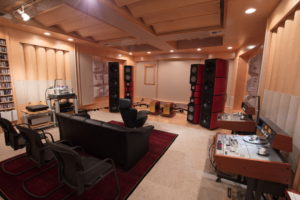Sound is a big part of what I do. I realize that might sound obvious, but I’ve been thinking a great deal lately about the role of sound. When shopping for an instrument or bow, I often hear statements like “sound is most important” or “it needs to have great sound”. The basic assumption is often that sound is something easily quantifiable or that there are universal standards by which we can judge sound. Another assumption I often encounter is that if someone is a great instrumentalist they will also be a great judge of sound. The reality is that I know many great instrumentalists who, while being excellent at identifying sound that adheres to their personal ideal, do not have a great deal of experience analyzing and comparing sound.
A long time hobby of mine is surprisingly helpful when it comes to analyzing and comparing sound. For over twenty years, I have been involved in the hobby of high-fidelity audio. Even this fairly small niche is divided into numerous subcategories, but for today’s purposes I’ll define it as the pursuit of reproducing recorded music in an authentic way. For some people that means hearing what the recording engineer heard, and for others that means trying to replicate the sound of a live performance. In all this time I’ve been involved in this hobby, I’ve owned countless different pairs of speakers, headphones, amplifiers, digital sources, analogue sources, and a myriad of accessories. With each one of these changes in equipment, my favorite recordings sounded slightly different. In analyzing and comparing those differences, I began to not only identify the attributes that were most important to my enjoyment of the experience, but also the difference between better/worse judgments and preference judgments. To put it another way – if your entire record collection consists of solo harpsichord recordings, you will likely choose one type of stereo system. If your entire record collection consists of heavy metal, your choice will most likely be different. One system is not necessarily better than the other, they simply emphasize different attributes of sound reproduction.
Next week I’ll have the opportunity to visit an audio show where hundreds of different stereo systems will be set up for evaluation. I could play the same recording in every single room and nearly every one will sound different. While the audio hobby can (and does) easily descend into the realm of the insane, having access to the ability to hear your favorite recordings with some degree of accuracy is beneficial to EVERY musician. An iPhone, a compact digital-to-analogue converter with headphone amplifier, and a decent pair of headphones can get you extremely close to the best sound money can buy…for less money than cellists spend on a set of strings. If the only way you ever listen to music is through the pair of earbud headphones that came with your phone, I highly recommend you make the investment in something better. Feel free to ask me about it…if you have a few minutes. I’ll try not to talk your ear off!
Is there a moral to this rambling story about one of my esoteric hobbies? Perhaps just that I am slow to call the sound of one instrument “bad” and another “good”. There are certainly BAD sounding instruments…but a big part of my job is to make sure they aren’t part of the collection we offer. Instead, I use phrases like “I prefer the sound of this instrument over that” or simply attempt to describe the sound – “that instrument has a brighter, clearer, more focused sound while this instrument is darker, warmer, and richer sounding”. Among musicians, a little empathy and humility can go a long way. I’ve heard people declare their ideal sound as the “best” sound. While it very well might be the best sound for them, it is helpful to realize that not everyone wants to sound the same. I am extremely grateful that people have different sound ideals and that there are instruments available to suit them all!
(NOTE: this is NOT my stereo system!)


Recent Comments